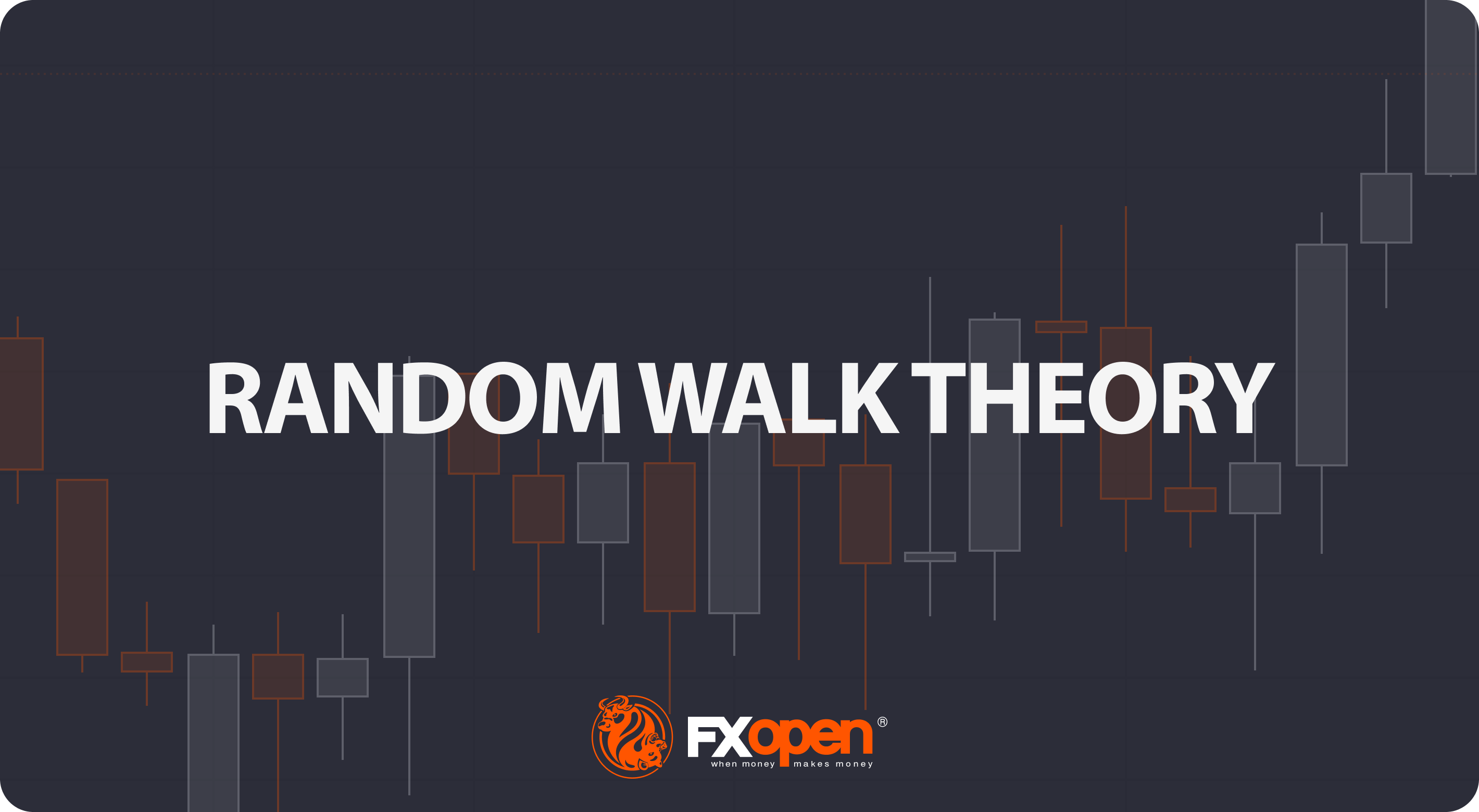What Is Random Walk Theory and Its Implications in Trading?

Random walk theory argues that market prices move erratic, making it difficult to analyse past data for an advantage. It suggests that technical and fundamental analysis provide little to no edge, as prices instantly reflect all available information. While some traders embrace this idea, others challenge it. This article explores the theory, its implications, criticisms, and what it means for traders navigating financial markets.
What Is Random Walk Theory?
Random walk theory reflects the idea that financial markets move erratic, making it impossible to analyse past price data for an advantage. The theory argues that price changes are random and independent, meaning past movements dont influence future direction. This challenges both technical and fundamental analysis, arguing traders who attempt to time the market are essentially guessing.
The concept was first introduced by Maurice Kendall in 1953, who found no meaningful patterns in stock prices. Later, Burton Malkiel popularised it in A Random Walk Down Wall Street (1973), arguing that a blindfolded monkey throwing darts at a stock list would perform as well as professional traders. The underlying principle is that markets are efficient, instantly reflecting all available information.
The theory states that prices truly follow a random path, so a trader analysing charts or company reports has no statistical edge. Its like flipping a cointhe next move is unrelated to the last. This has major implications: active trading strategies become questionable, and passive investing (e.g., index funds) may be a more logical approach.
However, while randomness can explain short-term price movements, longer-term trends still emerge. Factors like liquidity, institutional flows, and investor psychology create periods where price action deviates from pure randomness. This is where the debate arisesare markets entirely random, or do trends exist that skilled traders can take advantage of?
Understanding random walk theory helps frame this debate, offering insight into why some traders dismiss traditional analysis while others continue searching for patterns in price action.
Theoretical Foundations and Key Assumptions
The random walk hypothesis is based on mathematical models and probability, arguing that financial markets follow a stochastic processwhere future price movements are independent of past trends. It builds on several key principles that shape how economists and traders view market efficiency and price behaviour.
Market Efficiency and Information Absorption
A core assumption of random walk models is that markets are efficient, meaning all available information is already reflected in asset prices. If new data emerges, prices adjust instantly, making it impossible to gain an edge through analysis. This aligns with the Efficient Market Hypothesis (EMH), which classifies efficiency into three forms:
- Weak form: Prices already reflect past movements, rendering technical analysis ineffective.
- Semi-strong form: Fundamental data (e.g., earnings reports) is priced in immediately, limiting the usefulness of research.
- Strong form: Even insider information is priced in, meaning no trader has an advantage.
Brownian Motion and Stochastic Processes
The theory borrows from Brownian motion, a model describing random movement, often used in random walk algorithms to simulate stock price fluctuations. Prices are treated as a series of independent events, much like molecules colliding in a gas.
No Clear Patterns
If prices truly follow a random walk, trends and cycles do not exist in a statistically significant way. This challenges traders who attempt to use historical data to analyse future movements.
Implications for Traders and Investors
If random walks in trading are truly the norm, then analysing market movements using historical price data is no more effective than flipping a coin. This has significant implications for both traders and long-term investors.
For traders relying on technical analysis, random walk theory presents a major problem. If price changes are independent, then tools like support and resistance, trendlines, and moving averages hold no real value. The same applies to fundamental analysisif all available information is instantly priced in, then even detailed financial research doesnt offer an edge.
This would mean day traders and swing traders arent consistently able to generate higher returns than the broader market. Its why proponents of the theory often argue that attempting to time the market is a losing battle in the long run.
However, many supporters of the random walk theory advocate for passive investing, arguing that since, for example, individual stock movements are erratic, holding a diversified index fund is a more rational approach. Instead of trying to outperform the market, investors simply track it, reducing costs associated with frequent trading.
Criticism and Counterarguments
While random walk theory argues that market movements are independent, real-world trading data argues that markets are not entirely random. Critics point to patterns, inefficiencies, and the effectiveness of certain trading strategies as evidence that price action isnt purely a coin flip.
Market Inefficiencies Exist
One of the biggest challenges to random walk theory is that markets display recurring inefficiencies. Certain price behaviours, like momentum effects, mean reversion, and seasonal trends, suggest that past movements do have an impact on future price action. For example:
- Momentum strategies: Studies show that assets that have performed well over the past three to twelve months tend to continue in the same direction. If price action were purely random, these trends wouldnt exist.
- Earnings reactions: Stock prices often drift in the direction of an earnings surprise for weeks after the announcement. If markets were perfectly efficient, all adjustments would happen instantly.
Real Results
Random walk theory suggests that no trader can systematically outperform the market over time. Yet, some fund managers and proprietary traders have done exactly that. Warren Buffetts long-term track record is often cited as evidence that skill, not just luck, plays a role in investing and trading. Similarly, hedge funds employing quantitative strategies have consistently generated returns, challenging the idea that price movements are entirely random.
The Adaptive Markets Hypothesis
A more flexible alternative is Andrew Los Adaptive Markets Hypothesis, which seeks to reconcile the EMHs claim that markets are rational and efficient with behavioural economists argument that markets are, in reality, irrational and inefficient. Instead of being entirely random, markets evolve based on participants actions, allowing patterns to emerge.
While random walk theory provides a useful framework, real market behaviour often deviates from its assumptions, leaving room for traders to find potential opportunities beyond pure randomness.
Practical Considerations for Traders
Even if markets exhibit randomness in the short term, traders still need a structured approach to analysing price action and managing risk. While random walk theory challenges traditional methods, it doesnt mean traders should abandon analysis altogether. Instead, it highlights the importance of probabilistic thinking, risk control, and understanding market conditions.
Short-Term vs. Long-Term Price Behaviour
Markets may behave randomly on a daily or weekly basis, but longer-term trends can emerge due to liquidity shifts, institutional positioning, and macroeconomic factors. Traders focusing on short-term moves often work with probabilities, using statistical models and historical tendencies to assess risk and potential trade opportunities.
Track both short- and long-term price behaviour across more than 700 assets in FXOpens TickTrader platform.
Risk Management in an Uncertain Market
If price movements are largely unpredictable, risk control becomes even more important. Traders typically limit their exposure using stop losses, position sizing, and diversification to avoid being caught on the wrong side of market volatility. Instead of focusing on certainty, they manage the probability of different outcomes.
The Role of Quantitative Strategies
While traditional chart patterns may be questioned under random walk theory, quantitative and algorithmic strategies analyse large datasets to identify inefficiencies. High-frequency trading firms, for example, exploit microsecond price discrepancies that arent visible to the human eye.
Rather than proving whether markets are fully random, traders adapt by testing, refining, and adjusting their strategies based on what works in real conditions. The most experienced traders accept uncertainty but structure their approach around probabilities and risk management.
The Bottom Line
Random walk theory challenges the idea that past price movements provide an edge, arguing that markets move erratically. While some traders accept this and focus on passive investing, others analyse inefficiencies to find potential opportunities.
Whether you trade short-term movements or long-term trends, understanding market randomness is essential. Consider opening an FXOpen account to deploy your strategy across more than 700 markets on four advanced trading platforms with tight spreads.
FAQ
What Is the Random Walk Theory?
Random walk theory suggests that asset prices move unpredictably, with past movements having no influence on future direction. It argues that markets are efficient, meaning all available information is instantly reflected in prices. This challenges the idea that traders can consistently outperform the market using technical or fundamental analysis.
What Is the Meaning of the Random Walk Fallacy?
Critics of the theory argue that the random walk fallacy is the mistaken belief that financial markets move in a completely random manner, disregarding factors such as fundamental analysis, technical patterns, and behavioural finance that can influence price trends. This misconception may cause traders to overlook potential opportunities for strategic analysis.
What Are the Criticisms of Random Walk Theory?
Critics argue that markets display patterns, inefficiencies, and behavioural biases that contradict pure randomness. Studies on momentum, mean reversion and liquidity effects show that past price movements do influence future trends.
Read more: https://fxopen.com/blog/en/what-is-random-walk-theory-and-its-implications-in-trading/
Text source: Forex Trading Blog










